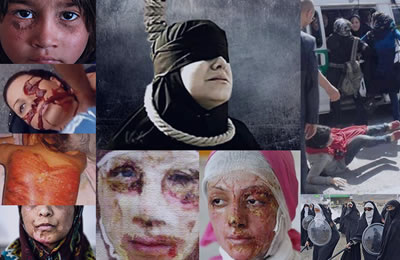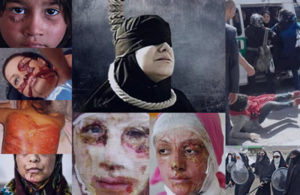

37 years on, the mullahs’ regime has not eased up on its violent policies and conducts against Iran’s women and girls because it is a misogynous regime founded on suppression of women and discrimination against them.
The state-sponsored nature of violence against women in Iran calls for the international community’s measure to hold the Iranian regime accountable for violating its international obligations to uphold women’s rights.
The clerical regime’s Constitution and laws institutionalize violence and discrimination against women and sanction the cruel punishment of stoning.
Iran is the only country in the world where women have been executed or tortured to death by the thousands for their opposition. In the 1980s, tens of thousands of PMOI women were massacred by the regime for exercising their freedom of speech and thought. They included teenage girls, pregnant women and elderly mothers. In 1988, thousands of women were among the 30,000 political prisoners massacred and buried in unmarked mass graves across the country.
The memoirs, an audio clip and the letters of Ayatollah Hossein-Ali Montazeri, the ousted heir to the mullahs’ leader Ruhollah Khomeini, have documented some of the most vicious instances of torture, rape, and execution of dissident girls and women in Iranian jails.
More recently, 17 women were killed and six others kidnapped and taken hostage by the Iranian regime’s mercenaries in bloody attacks on the Iranian opposition PMOI in camps Ashraf and Liberty between April 2011 and November 2015.
Female political prisoners in Iran suffer tremendously. After spending long periods in solitary confinement under torture and interrogation, these women are sentenced to lengthy prison sentences where they contract various illnesses. Prison authorities, however, deprive them from having access to medical treatment and leave them to suffer and die gradually. Maryam Akbari Monfared, Zahra Zehtabchi, Reyhaneh Haj Ibrahim, Fatemeh Mosanna, Nargess Mohammadi, Zeinab Jalalian, and Maryam Naghash Zargaran, are to name a few.
Another manifestation of the state-sponsored violence against women in Iran is the security forces’ brutal raids on gatherings of ordinary citizens who express their grievances. Just recently, on November 21, 2016, in Tehran, security forces and plainclothes agents raided the gathering of a group of women in front of the parliament, savagely beat up and shoved them around, and arrested at least 30 women.
At least 71 women have been executed during Rouhani’s tenure.
Government officials and clerics continue to incite the public against women, calling “mal-veiled” women the agents of enemy. On May 9, 2016, Ali Khamenei weighed in and reiterated the need to be harsh on the issue of women’s compulsory veiling. “We must not suffice to a mere verbal prohibition,” he said. Khamenei thus sanctioned physical encounters with women who flout the mandatory veil and dress code.
The outrageous series of acid attacks on women in various cities were the product of such provocations. Given the regime’s reluctance to arrest the culprits and grant support to the victims, using acid to attack women for vengeance has turned into a common practice. Not a week goes by without several incidents of acid splashing on women in the news.
This year, the government deployed a special moral police, 7000 undercover and plainclothes agents in Tehran, and a new front called the “National, Popular Front for Virtue and Veiling” which is made up of 301 active institutes to monitor women’s hijab in the streets and behind the wheels across the country and deal with them accordingly. These are in addition to the 26 government agencies and ministries which were already in charge of suppression of women.
In an unprecedented development this year, flogging was added to the official list of punishments for women. Young women and even girl children were flogged in Tehran, Qazvin, Golpayegan (Isfahan), Mashhad and Kerman.
School authorities in the southern Iranian village of Mokhtarabad in Kerman struck eight lashes of the whip, each, to at least ten girl students because their parents did not afford to pay 30,000 toumans (approx. $8.5) demanded by the school’s principal. On other instances, young women were flogged as many as 99 lashes for participating in protest demonstrations, or in birthday and graduation parties.
Also on November 17, 2016, a municipality agent in Fouman (northern Iran) beat a destitute woman in the head who was peddling in the street, sparking tremendous outrage among the public.
As for domestic violence, the news of torture and murder of women by their husbands hit a record high between March and June 2016. At least in ten cases, the victims ranging from a six-year-old girl to a 50-year-old woman did not survive the violence. In yet another case, neighbors in Mashhad accidentally discovered a woman and her two daughters and rescued them. They had been tortured for 21 days by their husband and father. It was later revealed that the woman had previously referred to judicial authorities to seek help but every time she had been sent back to her abusive husband.
29,131 women referred to the Coroner’s Office in April and May 2016, for injuries caused by fights. 5,200 cases of incest of young women and teenagers by their fathers and brothers have been filed with the Justice Ministry, just this year.
Obviously, the reports of violence against women whether obtained by relevant authorities or the media, comprise only a small portion of the actual number of such incidents as women fear reprisals at home or workplace, and most commonly are afraid of losing their honor in the eye of family and friends.
Violence against women and domestic violence are institutionalized in the law and official practices and not considered crimes in Iran. Victims of violence do not enjoy any government support, and worse, the Civil Code considers men as heads of the household and the house as their private property. Fathers and brothers are not blamed for killing their daughters and sisters since they own the latter’s blood under the law.
The worst aspect of violence against women in Iran is that it is state-sponsored. The government officials and institutions promote and provoke violence against women in society, in schools, in the streets, in the Friday prayers, in the media, and everywhere.
As long as this misogynous regime is in power, women’s rights could not be upheld. So Iranian women’s active engagement in the movement for regime change in Iran is a historical necessity. In the meantime, the international community must adopt measures and mechanisms to hold such states, including the Iranian regime, accountable for their crimes against women.

